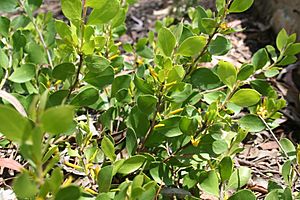Clandulla geebung facts for kids
Quick facts for kids Clandulla geebung |
|
|---|---|
 |
|
| Persoonia marginata in the ANBG | |
| Conservation status | |
| Scientific classification | |
| Genus: |
Persoonia
|
| Species: |
marginata
|
The Clandulla geebung, also known as Persoonia marginata, is a special plant found only in New South Wales, Australia. It belongs to the Proteaceae plant family. This plant is a low, spreading shrub with unique leaves and pretty yellow flowers.
Contents
What Does the Clandulla Geebung Look Like?
The Clandulla geebung is a low, spreading shrub. It usually grows to about 0.5 m (2 ft) (1.6 feet) tall and 1 m (3 ft) (3.3 feet) wide. When the plant is young, its branches and leaves have some soft hairs. As it gets older, these parts become smooth.
Leaves and Flowers
The leaves of the Clandulla geebung are arranged one after another along the stem. They are shaped like an oval or an egg, with the narrower part closer to the stem. Each leaf is about 20–40 mm (0.8–2 in) (0.8-1.6 inches) long and 6–23 mm (0.2–0.9 in) (0.2-0.9 inches) wide. Both sides of the leaf are the same color.
The flowers grow in small groups of two to four, often near where the leaves join the stem. Each group has a short stalk, and each flower has its own small, slightly hairy stem. The flowers are bright yellow and are made of four petal-like parts called tepals. These tepals are about 8–12 mm (0.3–0.5 in) (0.3-0.5 inches) long. They are joined at the bottom, but their tips curl back.
Inside the flower, there's a central part called the style. This style is surrounded by four yellow parts called anthers, which hold the pollen. The anthers are also joined at their base, and their tips curl back. If you look at the flower from the end, these parts look like a cross. The part of the flower that will become the fruit is covered in dense grey hairs.
When Does it Flower and Fruit?
Clandulla geebungs usually flower in January and February. After flowering, they produce smooth, green fruits. These fruits are a type of drupe, which means they have a fleshy outer part and a hard pit or "stone" inside, like a peach or cherry.
Where Does the Clandulla Geebung Live?
This special plant grows in woodlands and forests. It prefers sandy soils that come from sandstone rocks. You can find it in the Central Tablelands and Central Coast regions of New South Wales.
Main Locations
The Clandulla geebung is most common in the Clandulla State Forest, which is near a town called Kandos. There are also smaller groups of these plants in other state forests and national parks, such as Turon National Park and Gardens of Stone National Park.
Why is the Clandulla Geebung Important?
The Clandulla geebung is listed as "Vulnerable." This means its populations are at risk and could become endangered if we don't protect them.
Threats to the Plant
Several things threaten the Clandulla geebung:
- Habitat Loss: Activities like logging and building new roads can destroy the places where these plants grow.
- Recreational Activities: People using the forests for fun can sometimes harm the plants or their environment.
- Fires: Too many fires, or fires that happen too often, can damage the plants and stop them from growing back.
- Weeds: Invasive weeds can take over the area and compete with the geebung for space and resources.
- Diseases: Fungal diseases can also harm the plants.
Both the Australian government and the New South Wales government have laws to protect the Clandulla geebung. These laws aim to help this unique plant survive and thrive in its natural home.


